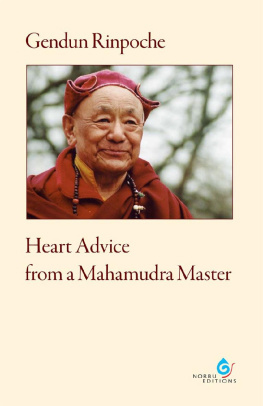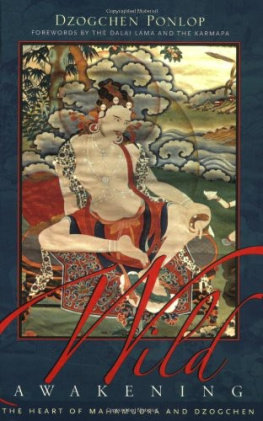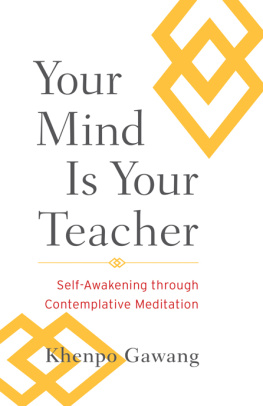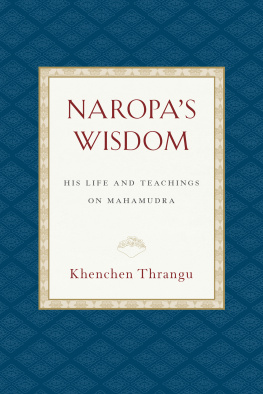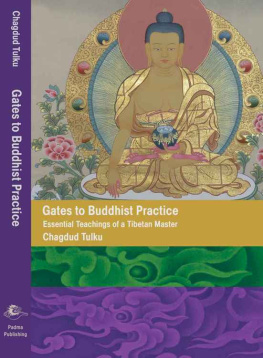Introduction
a master from the Kagyu tradition of Tibetan Buddhism. His teachings show us the Buddhist path all the way to complete awakening, starting from the most basic instructions. Lama Gendun, as we simply called him, brought the teachings of the Buddha into our lives lives that had been molded by Western culture.
He did not only instruct us through his words, he also showed us the path of awakening through his living example. Through his clear words we meet his clear and pure being; his simple teachings have the power to change our lives. When he was teaching, at times he began to speak in verse or even expressed the liberating truth in song. We have included six of his spontaneous songs in this book. In the Tibetan Buddhist tradition it is not uncommon for awakened masters to express the qualities of awakening in such songs or poems. As a spontaneous expression of their liberated mind they invite us to release our own mind into this state of openness.
and can be regarded as representative of the approach of the Kagyu tradition of Tibetan Buddhism. They comprise advice on how to practice in all aspects of our lives practice that will undoubtedly greatly challenge us but will also bear rich fruit. What that fruit may come to look like can be seen in the life of Gendun Rinpoche which serves as a particularly inspiring example of what a person can achieve.
If we wish to follow this path of awakening, nothing is more beneficial than to personally encounter a master who can explain the path in clear, easily understood words that lay it out step by step. The instructions in this book are the record of such a meeting of a Buddhist meditation master from Tibet with students from the West.
In the Buddhist tradition, the essence of the transmission is embodied in the spiritual master. So we should not only seek the teachings in texts but also engage in a living relationship with such a master. This form of oral transmission from teacher to student has continued without a break from the time of the Buddha, roughly 500 B . C ., until today.
From 1975 until his death in 1997, he lived in France and taught in many countries.
Everything Gendun Rinpoche taught, he had deeply realized himself. As an exemplary monk, perfect bodhisattva and realized yogi, in these teachings he addresses people from all walks of life. He stresses the necessity for all practitioners to open their hearts and develop compassion and devotion as well as to practice deep relaxation and letting go of all self-centeredness.
This book, of course, can only reproduce his words and not his surprising, flashing humor, his easy laugh, his inimitably varied tone of voice, his apt facial expressions, the flowing, perfect gestures of his hands and the love that radiated from his eyes. But today, as when he was alive, his words can still help us access the essential core of the teaching of awakening. He only taught what is truly important for us on the path to awakening and enlightenment. His words come straight from the heart, from the rich treasure of his personal experience.
In the following chapters, Gendun Rinpoche explains the basics of Buddhist practice. He talks about how to find our direction or refuge and familiarizes us with the ways in which we can generate the mind of awakening (bodhicitta) . Only when such a basis has been established will his explanations of the nature of mind and of Mahamudra meditation fall on fertile soil. He goes into many of the difficulties that we may encounter on the path, describes the mechanisms of our afflictive emotions and details how we can free ourselves from them. Finally, he explains how we can use our life in order to prepare now for death, even though we imagine that it is still far away.
In this way, the reader is guided through a cycle of instructions that Gendun Rinpoche frequently gave to his Western students. We learn how we can develop compassion and devotion and practice deep meditation, following in the footsteps of the great Buddhist masters. We find out how to work with the energies of our mind and how to bring forth the wisdom that will change our lives from the ground up.
Only intensive meditation practice will make it possible for us to penetrate the veils of our ignorance and recognize the nature of mind and of all appearances. When we receive guidance in this through the oral instructions of an experienced master, we quickly and without great difficulties or detours arrive at a personal, direct understanding of the teachings of the Buddha.
This close relationship between teacher and student persists until the student has attained direct and unequivocal insight into the nature of mind. Realized students then become teachers and pass on the instructions. Through this mode of transmission, the original realization of enlightenment that the historical Buddha Shakyamuni experienced underneath the bodhi tree has remained alive until today.
When Gendun Rinpoche taught, his listeners often had the feeling that the historical Buddha was speaking through him. A written compilation of his teachings cannot reproduce more than the external form of this exceedingly vivid transmission. Its full content will disclose itself only through profound contemplation and meditation as well as through contact with a qualified teacher.
We will derive the maximum benefit from this book if we pause again and again to let what we have read affect us deeply and to relate it to our own thoughts and experiences. The true meaning of these instructions, however, will open up to us only through personal meditation practice. Gom, the Tibetan word for meditation, means to practice, to accustom ourselves to a practice or view, to engage with it time and again, until its true meaning is revealed to us.
The present text was compiled from public talks and personal interviews that Gendun Rinpoche gave between 1990 and 1997. One of our objectives was to retain the natural flow of his instructions. Sentences in italics summarize the content of surrounding passages or are characteristic expressions of Gendun Rinpoche. To clarify a subject by looking at it repeatedly from different angles was part of his teaching style, so the occasional repetitions are quite intentional.
The biographical chapter is quite full and detailed, to make this information widely available and prevent it from being lost over the years. Readers who dont already have a connection with Gendun Rinpoche or who are relatively new to Tibetan Buddhism may not find it all of interest. If so, please just skim over any technicalities.
However, the basic story of Gendun Rinpoches tireless practice in Tibet, his almost miraculous escape to India, his devotion to his teacher the Karmapa , and how he gave himself wholeheartedly to the task of helping his western students and establishing the Dharma in Europe all this can inspire us in our lives regardless of whether we know much about Tibetan Buddhism or have ever heard of Gendun Rinpoche before.

